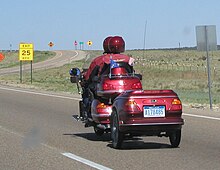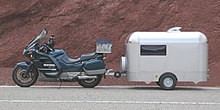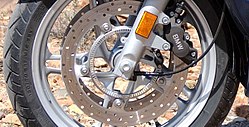|
Motorcycle trailer   A motorcycle trailer is either a trailer used to carry motorcycles or one to be pulled by a motorcycle in order to carry additional gear. Motorcycle carrying trailersMotorcycle carrying trailers may be open or enclosed. They may be wide, for two machines side-by-side, or narrow, for just a single machine. The main features that distinguish them from other flatbed or enclosed trailers are track(s) to keep the wheels from sliding side to side and sufficient tiedown points to keep the motorcycle(s) from tipping. They may also tilt, or include ramp(s) to facilitate the loading and unloading of motorcycles. Trailer manufacturers often offer trailers specifically designed for carrying motorcycles. General purpose enclosed trailers, as seen in the photo above left, have the advantage of providing a more secure way of locking up the motorcycles contained within it, keeping them out of sight, and protecting them from all kinds of weather. However, as they are heavier than open trailers and create more wind resistance, pulling a general purpose enclosed trailer can decrease the fuel efficiency of the tow vehicle. Conversely, an enclosed motorcycle-specific trailer can be built low enough so that wind resistance is reduced. As a result, fuel efficiency is better than towing a general purpose enclosed trailer. Collapsible or folding motorcycle trailers are available to overcome storage problems that might prevent use of a non-collapsible trailer, some such trailers are sufficiently compact to allow the user to carry the trailer in the trunk of a car when not in use. TypesThe basic motorcycle trailer design consists of a fixed platform mounted above one or more axles, which requires the motorcycle be loaded by physically lifting it or rolling it up a ramp onto the platform, potentially a difficult problem when dealing with a heavy touring machine or one that has been disabled. Since the latter half of the 20th century a number of different trailer styles have been devised to make loading motorcycles on them easier. Broadly, such designs include:
Trailers pulled behind motorcycles      Trailers towed behind motorcycles are distinguished by their relatively small size, especially narrow wheelbase. They are also often styled to match the look of the motorcycle they are intended to be towed behind. This styling can include the overall shape, fender shape, lights, chrome, etc. TypesCargo trailersCargo trailers provide extra storage space on for bikers whose motorcycles have little storage. The most popular models are made of fibreglass or aluminium and ride on two wheels. Open or utility trailerMotorcycle utility trailers are uncovered, single-axle, flatbed trailers. These trailers are designed to be towed by a motorcycle, so they are much smaller than standard open trailers which must be towed by a four-wheel vehicle. Dog trailerMotorcycle dog trailers are designed to transport the animals in safety and comfort. They are fully enclosed, well ventilated and have suspension. Motorcycle camping trailersTwo types of trailers prevail within the motorcycle camping trailers category: clamshell and platform camper trailers. Fabric material is attached to the top and bottom halves of the clamshell trailer. The tent is created when the trailer is opened. Once a platform camping trailer is opened, however, the tent is pitched on it. These platform style camping trailers are larger than clamshell camping trailers and can fit full-sized to king-sized air mattresses. Most often, clamshells can only accommodate a single occupant. The Pav 40/41/100The Pav trailers were manufactured in the Czech Republic, originally by "AVIA n.p". and later by "KOVOZAVODY SEMILY" by Jawa Moto. Earliest examples were made in the mid- to late-1950s, which pre-date the PAV 40. The PAV 40 debuted in approximately 1958 or 1959. The PAV 41 eventually replaced the PAV 40 and was produced into the 1970s. Pav trailers feature a single 4-inch (102 mm) wheel and are rated to 80 km/h (50 mph). They were made to be attached to Jawa motorcycles, although they make excellent accessories for Vespa, Lambretta, Cezeta, Heinkel, Fuji, Zundapp, Cushman, or any other vintage motorcycle, scooter or microcar (like Isetta or Messerschmitt). Having just one wheel, these trailers are attached to the towing vehicle by a hitch that has only two degrees of freedom — pitch and yaw. Hitching a trailer to a motorcycleIn order to tow a trailer behind a motorcycle, one of the following coupling combinations or mechanisms is needed: a ball and socket, swivel adapter, or pivot ball hitch and coupler. Ball and socket Most trailers are towed by joining a ball and a coupler (socket).[1] The coupler is attached to the trailer, and the ball hitch is attached to the tow vehicle. The coupler slides over the ball hitch. Then, pressure is applied to a clamp, usually with a toggle or lever, which secures the ball in the coupler. When properly attached, the coupler will have limited movement, swiveling mainly right and left as well as tilting slightly. Swivel adapter (swivel coupler - swivel hitch) The swivel adapter, more commonly referred to as a swivel coupler or swivel hitch, functions by connecting one end to the trailer tongue and the other end directly to the hitch on the tow vehicle or to a coupler. This mechanism is engineered to rotate on the vertical axis so as to eliminate the possibility of coupler binding. As a result, the motorcyclist is able to lean into a turn as far as necessary at high speeds while keeping the trailer upright. Anti-binding motorcycle trailer hitch assembly (pivot ball hitch) The pivot ball hitch is an anti-binding motorcycle trailer hitch assembly composed of a base and a trailer ball. The base is secured to a standard ball mount on the motorcycle. The trailer is attached to a socket coupler. A space between the ball shank and the assembly mount allow the ball to move left and right in a vertical plane. Thus, the ball remains in a generally upright position when the motorcycle leans left or right into a turn because the base of the pivot ball hitch is able to move in the opposite direction of the motorcycle without causing the coupler to bind.[2] Coupler bindingMaking a turn on a single-track vehicle such as a two-wheeled motorcycle requires the driver to lean the bike. The amount of the lean is dependent upon the speed. Faster speeds require more leaning than slower speeds do.[3] When making a turn with a trailer attached, the mechanism that joins the trailer to the motorcycle must allow for an appreciable lean in order for a trailer to stay upright. Without the ability to freely rotate on a vertical axis, the coupler will bind and the trailer will jack-knife or flip. As explained above in "Ball and socket", the movement in the coupler and ball combination is limited to mostly horizontal movement and tilting slightly. Therefore, this type of coupling is best suited for three-wheeled motorcycles and four-wheeled vehicles. In contrast, as pivot ball hitches and swivel adapters do allow the appreciable lean necessary to keep all the trailer wheels on the ground while turning, these devices are the better option for towing trailers behind a two-wheeled motorcycle.[1] However, the standard car type "ball and socket" couplings used in the United Kingdom are perfectly adequate for two wheeled motorcycles providing plenty of lean angle. Towing restrictions in the United KingdomIn the United Kingdom, there are some legal restrictions on towing trailers.[4]
SafetyTips for towing include:
World recordsThe Guinness World Record for a motorcycle and trailer is 139.5 mph, set in 2002 by Motor Cycle News (UK) towing a Squire D21 trailer behind a Kawasaki ZZ-R1100.[7] ReferencesWikimedia Commons has media related to Motorcycle carrying trailers.
Further reading |
